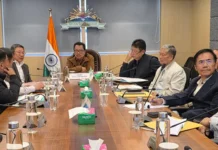[Tongam Rina]
Yet again, Arunachalee students have not done well in the Central Board of Secondary Education examination. The score is well below 50 percent in the overall pass percentages of Class 10 and 12.
The nationwide pass percentage of Class 10 stood at 91.10, while in Arunachal it was 41.13. The state’s pass percentage is a significant improvement from last year’s 21.16. An increase of 19.97 in the pass percentage in one year is a commendable effort.
In Class 12, the all India pass percentage was 83.4. The pass percentage in Arunachal was 41.96 – a decrease of 2.39 percent from last year’s 44.35 percent.
These statistics are testimony that the education system in Arunachal needs to be fixed. The consistent non-performance is not the fault of the students alone. The state requires an overhaul of the education system, starting with recruitment of trained teachers.
One of the main reasons appears to be shortage of teachers. According to the figures given by the education department, of the 101 government higher secondary schools, 65 have shortage of subject teachers. Of the 184 government secondary schools (GSS), 68 have acute shortage of subject teachers. Of these 184 schools, 81 are under the Rashtriya Madhyamik Shiksha Abhiyan, and are managed by contractual teachers.
The fact that so many schools are without teachers says a lot about the lack of political will to improve education in the state. No one has failed the students more than the executive who have not done enough to even ensure bare minimum facilities.
On the other hand, more than two years after the state cabinet cleared 1130 posts of postgraduate and trained graduate teachers, the recruitment process is still ongoing under the Arunachal Pradesh Public Service Commission. The next academic session is starting in less than a month’s time, with the same problem of lack of teachers and other basic facilities still remaining.
Another problem seems to be the upgrading of schools without posting requisite number of teachers.
In the last few years, 25 schools have been upgraded to the higher secondary level but the facilities and the numbers of teachers have remained the same.
This rampant upgrading needs to be stopped. It is time for the administrators in the department to take a stand. The department seriously needs to contemplate what has to be done.
Delhi seems a good model to emulate, given the recent surge in facilities in government-run schools initiated by Arvind Kejriwal’s AAP government. Best practices from across the country need to be adopted by the department, so that poor children who go to government schools do not suffer year after year.
While deeper research must be done to find out where the fault lies and how to fix the loopholes in schools, emphasis has to be given to pre-primary school education in order to establish a strong foundation.



